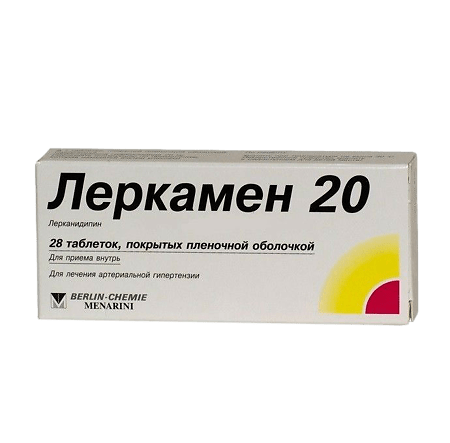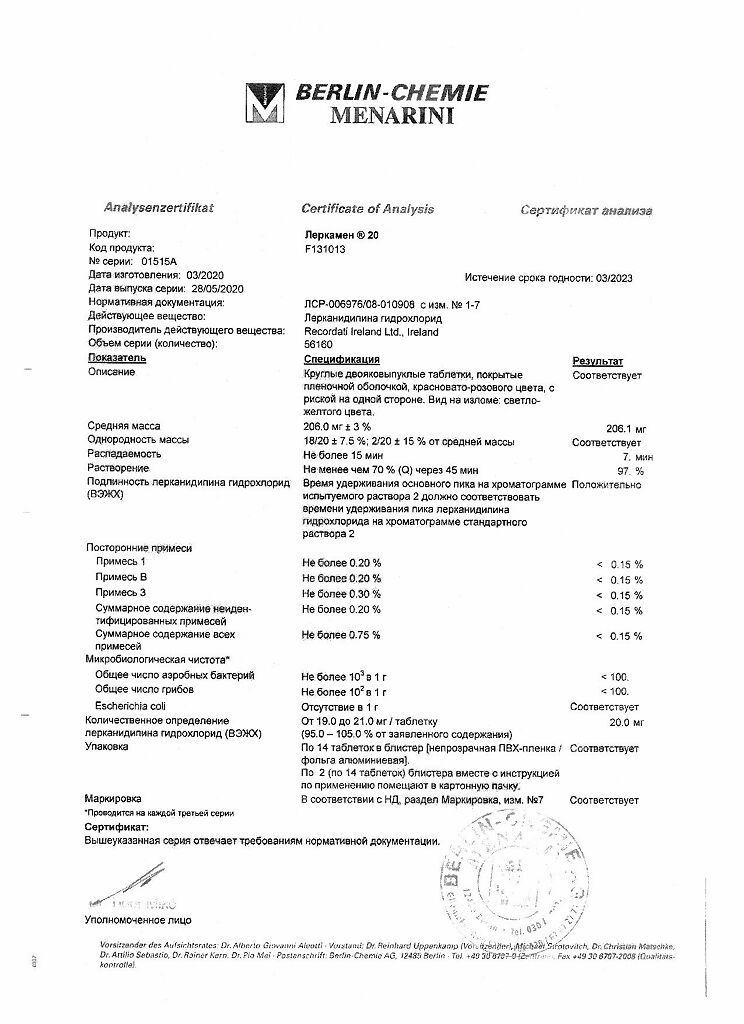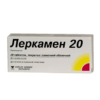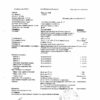No products in the cart.
Lercamen 20,20 mg 28 pcs.
€25.07 €20.89
Description
Selective slow calcium channel blocker with predominant effect on blood vessels, dihydropyridine derivative. Inhibits transmembrane flow of calcium ions into vascular smooth muscle cells. < br>
The mechanism of antihypertensive action of lercanidipine is due to a direct relaxant effect on vascular smooth muscle cells, resulting in a decrease of RPS. Despite relatively short plasma elimination half-life, lercanidipine has prolonged antihypertensive effect due to high membrane distribution coefficient. < br>
Lack of negative inotropic effect due to high vascular selectivity. < br>
Acute arterial hypotension with reflex tachycardia occurs rarely due to the gradual development of vasodilation when taking lercanidipine. Lercanidipine is a racemic mixture of (+)R- and (-)S-enantiomers. The antihypertensive effect of lercanidipine is primarily due to the S-enantiomer. Duration of therapeutic effect – 24 h
< br>
Indications
Indications
Essential hypertension of I-II severity.
Pharmacological effect
Pharmacological effect
Selective blocker of slow calcium channels with a predominant effect on blood vessels, a dihydropyridine derivative. Inhibits the transmembrane flow of calcium ions into vascular smooth muscle cells.
The mechanism of the antihypertensive effect of lercanidipine is due to a direct relaxing effect on vascular smooth muscle cells, resulting in a decrease in peripheral vascular resistance. Despite the relatively short plasma half-life, lercanidipine has a prolonged antihypertensive effect due to its high membrane distribution coefficient.
Due to its high vascular selectivity, it does not have a negative inotropic effect.
Acute arterial hypotension with reflex tachycardia occurs rarely due to the gradual development of vasodilation when taking lercanidipine. Lercanidipine is a racemic mixture of (+)R- and (-)S-enantiomers. The antihypertensive effect of lercanidipine is primarily due to the S-enantiomer. Duration of therapeutic action – 24 hours
Special instructions
Special instructions
Impact on the ability to drive vehicles and other mechanisms that require increased concentration
Since dizziness, asthenia, fatigue and, in rare cases, drowsiness may occur during therapy with Lerkamen®, during the period of drug use, patients should be especially careful when driving vehicles and engaging in other potentially hazardous activities that require a high speed of psychomotor reactions.
Active ingredient
Active ingredient
Lercanidipine
Composition
Composition
Active ingredients:
lercanidipine hydrochloride 20 mg.
Excipients:
lactose monohydrate – 60 mg,
microcrystalline cellulose – 78 mg,
sodium carboxymethyl starch (type A) – 31 mg,
povidone K30 – 9 mg,
magnesium stearate – 2 mg
Shell composition:
opadry 02F25077 – 6 mg (hypromellose – 3.825 mg, talc – 0.3 mg, titanium dioxide – 1.2 mg, macrogol 6000 – 0.6 mg, iron oxide (III) – 0.075 mg).
Pregnancy
Pregnancy
The use of Lerkamen® during pregnancy and breastfeeding, as well as in women of childbearing age in the absence of reliable contraception, is contraindicated.
Preclinical studies did not reveal a teratogenic effect of lercanidipine in rats and rabbits; the reproductive function of rats was unchanged.
Due to the lack of clinical experience with the use of lercanidipine during pregnancy and breastfeeding, and since other dihydropyridine derivatives are known to have a teratogenic effect in animals, lercanidipine is not recommended for use during pregnancy or in women of childbearing age who do not use reliable methods of contraception.
Due to the high lipophilicity of lercanidipine, it can be expected to pass into breast milk, so the drug is not recommended for use during breastfeeding.
Contraindications
Contraindications
Chronic heart failure (in the stage of decompensation); Unstable angina; aortic stenosis; within 1 month after myocardial infarction; severe liver dysfunction; impaired renal function (creatinine clearance less than 12 ml/min.); lactose intolerance, galactosemia. glucose/galactose malabsorption syndrome.
Pregnancy and breastfeeding; women of childbearing age who are not using reliable contraception; Age up to 18 years (efficacy and safety have not been established); Hypersensitivity to lercanidipine, other dihydropyridine derivatives or any component of the drug.
With caution: renal and/or liver failure, old age, sick sinus syndrome (without a pacemaker), coronary heart disease, left ventricular dysfunction.
Side Effects
Side Effects
The drug is well tolerated.
Rarely:
effects associated with the vasodilatory properties of the drug – peripheral edema, a feeling of flushing of the face, palpitations, tachycardia, chest pain, decreased blood pressure, angina pectoris, myocardial infarction, asthenia, fatigue, headache, dizziness: very rarely: gastrointestinal disorders (dyspepsia, nausea, vomiting, epigastric pain, diarrhea), increased activity “liver” enzymes (reversible), polyuria, skin rash, drowsiness, myalgia, gingival hyperplasia.
Interaction
Interaction
When carrying out complex therapy, it is well compatible with β-blockers. diuretics, angiotensin-converting enzyme inhibitors (ACEIs). When using Lerkamen 20 simultaneously with cardiac glycosides, it is necessary to conduct frequent monitoring for signs of digoxin intoxication.
Concomitant use with cimetidine does not cause significant changes in plasma concentrations of lercanidipine; at high doses of cimetidine, the bioavailability and hypotensive effect of lercanidipine may increase. Caution should be prescribed with CYP3A4 inhibitors: ketoconazole, intraconazole, erythromycin, etc. When Lerkamen 20 is prescribed together with CYP3A4 inducers: antidepressants, rifampicin, a decrease in the hypotensive effect of the drug is possible.
When drinking grapefruit juice, the hypotensive effect may be enhanced. Ethanol consumption may potentiate the effect of the drug. Effect on the ability to drive vehicles and operate machinery Since therapy with Lerkamen 20 may cause dizziness, asthenia, fatigue and, in rare cases, drowsiness, during the period of drug use, patients should be especially careful when driving and engaging in other potentially hazardous activities that require a high speed of psychomotor reactions.
Overdose
Overdose
Presumably, in case of an overdose of lercanidipine, symptoms similar to those of an overdose of other dihydropyridine derivatives will be observed: peripheral vasodilation with a pronounced decrease in blood pressure and reflex tachycardia.
Treatment: symptomatic therapy; in case of a pronounced decrease in blood pressure and loss of consciousness, cardiovascular therapy is indicated; in case of bradycardia, intravenous administration of atropine is indicated.
There is evidence of 3 cases of overdose when taking lercanidipine in doses of 150 mg, 280 mg and 800 mg for the purpose of suicide.
Drowsiness has been observed with lercanidipine 150 mg + alcohol (unspecified amount).
Treatment: gastric lavage, taking activated carbon.
When taking 280 mg of lercanidipine + 5.6 mg of moxonidine, the following symptoms were observed: cardiogenic shock, severe myocardial ischemia, mild renal failure.
Treatment: cardiac glycosides, diuretics (furosemide), high doses of catecholamines, plasma expanders. When taking 800 mg of lercanidipine, nausea and a marked decrease in blood pressure were observed.
Treatment: taking activated carbon and a laxative, intravenous dopamine.
In all cases of overdose, all patients survived. No information is available on the effectiveness of dialysis for lercanidipine. It is most likely that due to the high binding of lercanidipine to plasma proteins, dialysis may be ineffective.
Storage conditions
Storage conditions
Store out of the reach of children at a temperature not exceeding 30°C.
Shelf life
Shelf life
3 years.
Manufacturer
Manufacturer
Berlin-Chemie AG, Germany
Additional information
| Shelf life | 3 years. |
|---|---|
| Conditions of storage | Keep out of reach of children at temperatures under 30 ° C. |
| Manufacturer | Berlin-Chemie AG, Germany |
| Medication form | pills |
| Brand | Berlin-Chemie AG |
Related products
Buy Lercamen 20,20 mg 28 pcs. with delivery to USA, UK, Europe and over 120 other countries.

















